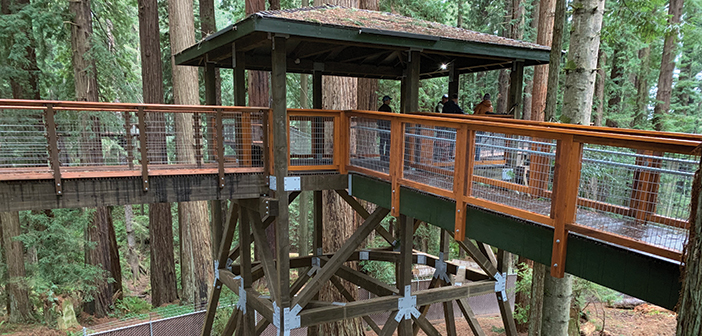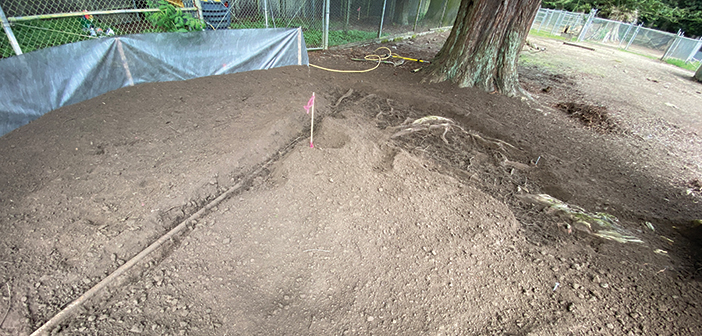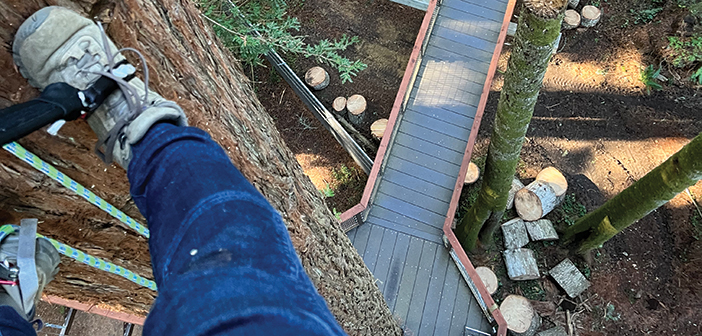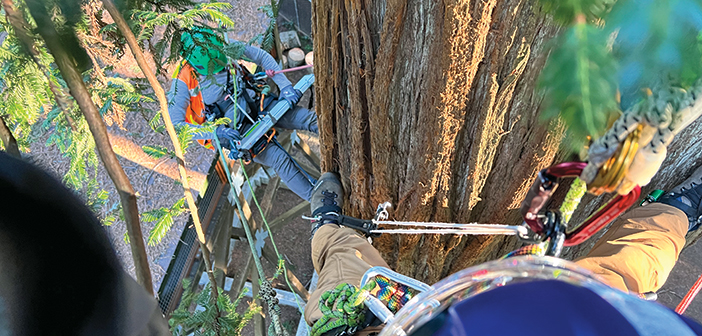Your facility and the property it’s situated on are part of an ecosystem. I believe this is the most important fact to keep in mind if you want to manage your course and the trees that support it for the long term. To me, ecosystem includes everything on the property, both natural and manmade. I often find that people don’t think about the manmade infrastructure that surrounds them as part of their ecosystem. This is a critical mistake.
When we install an adventure park or zip line tour in the forest, not only are we building structures and creating pathways within an existing ecosystem, we are often attaching manmade components to trees and putting foundations into the ground—literally connecting manmade to natural.
To properly manage and preserve this ecosystem requires planning, knowledge, and a bit of flexibility.
KNOW YOUR EXISTING ECOSYSTEM
How can you manage nature? First you need to understand and identify the components of the ecosystem your course exists within. Understand what tree species are supporting your structures and the roles of other plants, bacteria, and fungi present—all of which are essential to a healthy forest ecosystem.
Below-ground ecosystem. Science has shown us that all the plants in a forest are connected. Associated plants are essential to a functioning forest ecosystem. Rather than strictly being in competition, forest plants are often sharing resources and helping each other to survive and thrive. Much of this happens in the below-ground forest ecosystem, which is difficult to observe and understand—but easy to disturb.
Plans for building a new course should center on avoiding damage and disruption as much as possible. Remember that anything you do below ground or at the surface will have an impact on the soil ecosystem. Road cuts, utility trenching, tree removal and pruning, and trail construction should be done with minimal disruption. Even the staging of heavy materials on bare soil can reduce the amount of oxygen and water that moves through it.

This launch deck was built over the root systems of the nearby trees. With proper planning, it is possible to construct foundations that avoid impacting critical roots. Photo courtesy of Scott Baker.
Some disruption is unavoidable, like for foundations. But there are many construction techniques that allow below grade structures of various types to be built with minimal impact to tree root systems and forest soils.
Proper planning is paramount. It’s important to know where tree roots are located so you can plan around them and minimize potential damage. Accurate mapping of support trees, trees adjacent to the course, and other significant ecosystem components can help at the planning stage. A skilled arborist can use visual tree assessment to understand where you might have roots that would be impacted. And careful exploratory excavation using a pneumatic air tool can reveal the location of critical roots, thus avoiding impacts from construction.

Careful exploratory excavation can reveal critical roots to avoid during below-ground construction of things like a service line. Photo courtesy of Jim Campbell Spickler.
If you’ve thought about it in advance and worked with your engineer on a design that will allow for it, it’s generally possible to move a foundation or footing slightly at the time of construction to avoid a critical root without impacting the design or engineering.
Plan ahead to delineate trails that you will use to access the site and lay down areas for materials and other components of your construction. Make these plans a part of your contractual documents so any contractors understand in advance that they are required to follow them and limit impact to the site. Also, budget additional funds and time for unexpected changes and repairs.
Trees and forests are resilient, and with a little attention can be managed to improve the overall ecosystem’s conditions.
MONITORING AND MANAGEMENT
Devise a monitoring plan using the maps and plans you have created. Just as you will be regularly inspecting the hardware and functional systems for your course, you should be monitoring and inspecting the trees and other critical components of your ecosystem.
This requires some money in the budget. Inspections should be carried out by a qualified arborist or by a staff member with appropriate training, and money should be set aside for emergency inspections after significant weather events or other unexpected issues.

Trees and critical ecosystem components should be monitored and inspected just like courses and hardware. Photo courtesy of Scott Baker.
Active management. Because change is inevitable—and in many forested areas, environmental factors are causing significant tree mortality—you should be willing to manipulate and actively manage your site to keep the ecosystem healthy. For instance, if drought stress is present and you have the ability to provide some extra water to your course trees to help them get through, I say go for it. It doesn’t take a lot of water in many cases to give trees and forest plants some extra support. Consult a knowledgeable arborist to understand how much water is necessary.
Similarly, if you have trees at risk of insect attack or root disease is suspected or present, consider using integrated pest management approaches and potentially treatment to preserve critical trees, which a qualified arborist can provide.

Tree inspections should be performed by a qualified arborist. Here, a Tree Solutions arborist is doing a Level 3 tree assessment. Photo courtesy of Scott Baker
It’s my view that once you have built your course on a forested site, you’ve essentially turned it into a garden. Gardens require tending, and proper tending takes time and foresight. In my work in the city, I teach arborists to look at least 20 years back in time and to imagine 20 years into the future when assessing trees. I believe this approach is useful anywhere people are managing ecosystems.
TREE-SUPPORTED STRUCTURES
Keep in mind some of the basics about trees. Trees are not static. They are constantly adapting to their environment and to the loads they encounter. Trees can speed up or slow down their growth depending on the conditions. A good way to think about tree growth is to understand that a new tree grows around the existing tree every year until the tree dies.
As we build tree-supported structures, we are interrupting the tree’s basic structure with our attachments. It is important to understand the basics of a tree’s vascular system—the movement of water and nutrients from the soil up through the sap wood, and of the products of photosynthesis down through the cambium layers, is all essential to a functioning tree.
Every hole that we put in a tree is an injury. Trees will respond to these intrusions in predictable ways. Our goal should be to minimize penetrations so the tree is able to continue functioning physiologically.
Tree Solutions’ experience suggests limiting penetrations at any one level to a maximum of 20 percent of the tree circumference. When courses include several levels of attachments on the same tree, it’s important to consider how much interruption over the entire tree will occur. We have seen examples where multiple attachments on one tree have resulted in significant decline of the crown of the tree or death.
Adding loads to trees. When we attach trees together with zip line cables or bridges and add platforms to their structure, we are changing the loads that the tree will encounter. I don’t know of much research into the long-term impacts of cyclic loading of living trees.
However, we know a lot about the adaptive growth that can be expected—a vigorous tree will add wood to counter a new load. This is important, because faster growth in the area of an attachment will result in a shorter time until growth brings the tree into conflict with a structure.
Otherwise, it’s difficult to predict or measure other changes that may occur as a result of attaching trees together with zip cables or adding guy cables. I find it useful to observe courses from the ground under normal operational loads to see what’s moving as clients use the course. These observations can inform potential design tweaks, and help to see where problems may be occurring, so those areas can be monitored closer and undergo more focused inspections.
Additionally, designs that allow cables to be removed during the winter are smart because it reduces the likelihood of problems resulting from storm loads.
RESPONSE TO INJURY
We also know quite a bit about how trees respond when they are injured by a tree attachment bolt. Once the xylem or sapwood of the tree is penetrated, there will be a change in the characteristics of the wood in that area. Research indicates that these changes may favor fungi, making it easier for them to grow. When a tree is wounded it is likely that fungal associates will access the tree. If the tree already has decay present or old injuries that have triggered the compartmentalization response, it’s possible that decay will spread outwards in the tree because the new wound provides a path for it to spread.
Tree decays are caused by a variety of fungi, many of which are tree-species specific. These organisms grow within the biological structure of the tree. Fungi utilize the energy bound up in tree tissues for their own needs. Changes to the structure of the wood occur as the fungi grow. Trees affected by fungi can have various outcomes depending on the species of tree and the type of fungi that is present.
Humans tend to label these fungi as “pathogens,” however, I think it is useful to look at them more as part of the tree ecosystem.
Currently there are few strategies to limit fungal decay organisms. In the future, we may understand more and develop tools that would help extend the life of trees by limiting the spread of fungi. Currently, the best we can do is to select species that are long lived and decay resistant to use as support trees for structures.
Tools for assessment. Arboricultural science is giving us more tools that allow for the structural assessment of living trees. Micro-resistance drilling, sonic tomography, and statics-based testing are becoming more commonly available. We also understand more about how to use the data that can be collected to help direct engineers and course designers. Stay tuned for a future article discussing how to use what is called Level 3 assessment to understand the limits of trees on your course.
Scott Baker, RCA, is the principal and founder of Tree Solutions Inc. He has worked with trees for more than 45 years. His experience spans commercial arboriculture, tree diagnosis, treehouses, zip lines, construction and building codes. More Info: treesolutions.net.






